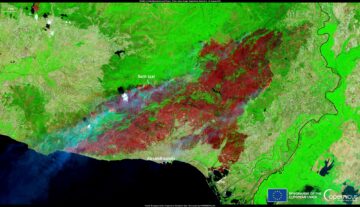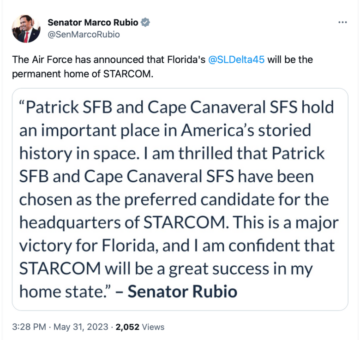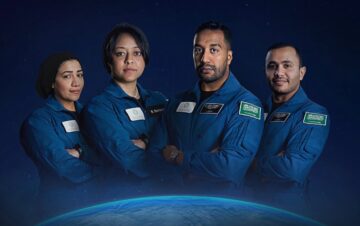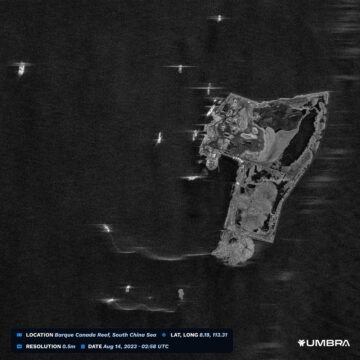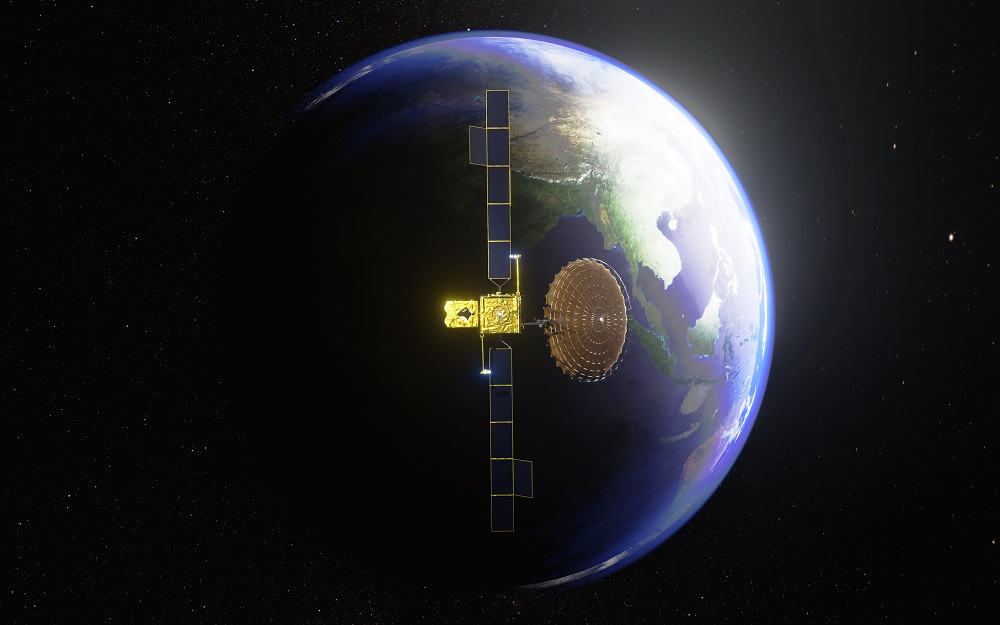
TAMPA, Fla. — Viasat is considering investing in spacecraft with other Mobile Satellite Service (MSS) operators as the promise of direct-to-smartphone technology drives unprecedented cooperation among historically isolated networks.
“What you’ve seen in MSS in the past is every operator has to have its own satellite, its own ground segment, its own type of terminals [and] they only use their own spectrum,” Viasat CEO Mark Dankberg said.
“But what we’re envisioning is creating an environment where you can roam from MSS operator to MSS operator seamlessly, and you can do that in different geographies or within the same geography.”
Pooling radiowaves in the same area could deliver more capacity for direct-to-smartphone services, enabling higher bandwidth text, voice, and data capabilities for phones outside cellular coverage.
Dankberg is chair of the Mobile Satellite Services Association (MSSA), a non-profit group of MSS operators founded in February to push the fledgling direct-to-smartphone market to adopt their radio waves, rather than spectrum sourced from terrestrial mobile network operators.
Other founding MSSA members include Terrestar Solutions, Ligado Networks, Omnispace, and Yahsat. Iridium Communications has also said it is considering joining MSSA after pivoting from a proprietary direct-to-smartphone strategy to an open network approach.
MSS operator Globalstar, which thanks to its close relationship with Apple has been enabling space-based SOS services on the latest iPhones since late 2022, is not part of MSSA.
“A satellite is just a cell tower in space,” Dankberg said in an interview. “The payload is what does the work. So just like in terrestrial, where you can put a payload — or a network — from multiple carriers on the same tower, why can’t we make the same satellites for all of our needs?”
Similar to how cell tower companies operate on the ground, he said sharing infrastructure in space could save costs and attract capital.
“We can have tower companies in space that can serve all of us [and are] far more capital efficient,” he added, “we can do similar things with ground infrastructure in particular markets.”
Coordination agreements among MSS operators currently separate them from each other to avoid radio wave interference. Through MSSA, the operators hope to create a standards-based framework that could pave the way for contractual agreements to share and empower their orbital resources.
Partnerships mobile network operators have with cell tower companies on the ground include leasing and revenue-sharing business models.
Dankberg pointed to Indian cellular operator Reliance Jio, which has helped lower barriers to entry through partnerships with power companies, network providers, and handset makers.
“What we’re looking to do is to figure out which of those we can replicate in what sequence,” he said.
“Maybe the MSS operators themselves cooperate, maybe third parties come in to invest in the space segment.”
The aim is to help build scale globally and drive out costs as direct-to-smartphone operators SpaceX, Lynk Global, and AST SpaceMobile seek more mobile network operator partners for their terrestrial spectrum approach.
“Coopertition is kind of the buzzword for that,” Dankberg added, “whereby cooperating we make the market bigger and we compete on that larger market, but that’s a way better way to compete than on the small market scales that at the MSS operators have now.”
According to Dankberg, existing regulations already support MSS spectrum pooling, and it is up to MSSA members to coordinate among themselves.
Regulatory clarity is one of the strengths of the MSS direct-to-smartphone approach because these radio waves are already cleared for use from space, although services to standard smartphones must wait for standardized chips to be released.
Satellites using cellular radio waves can reach smartphones already in circulation because these devices use these frequencies with land-based cell towers.
However, these terrestrial partnerships must first navigate new rules that must be put in place to guard against the possibility of interference in each country they wish to operate in.
The United States is taking the lead on this, and the Federal Communications Commission recently issued nationwide ground rules for what it calls Supplemental Coverage from Space that is expected to inspire other countries.
Meanwhile, Lynk Global is currently enabling intermittent texting services with five satellites in parts of a handful of island nations. Like fellow early-stage venture AST SpaceMobile, which does not expect to launch initial commercial satellites until at least July, Lynk is seeking more capital to expand its constellation.
Leveraging significantly greater financial resources, SpaceX aims to enable direct-to-smartphone texting services in the United States this year, with voice and data services slated to come soon after.
Omnispace, however, has warned that SpaceX’s plans to use T-Mobile’s cellular radio waves from space could cause interference that would derail its proposed MSS constellation.
- SEO Powered Content & PR Distribution. Get Amplified Today.
- PlatoData.Network Vertical Generative Ai. Empower Yourself. Access Here.
- PlatoAiStream. Web3 Intelligence. Knowledge Amplified. Access Here.
- PlatoESG. Carbon, CleanTech, Energy, Environment, Solar, Waste Management. Access Here.
- PlatoHealth. Biotech and Clinical Trials Intelligence. Access Here.
- Source: https://spacenews.com/banding-together-for-direct-to-smartphone-satellite-services/
- :has
- :is
- :not
- :where
- $UP
- 2022
- a
- added
- adopt
- After
- against
- agreements
- aim
- aims
- All
- already
- also
- Although
- among
- an
- and
- Apple
- approach
- ARE
- AREA
- AS
- Association
- At
- attract
- avoid
- Bandwidth
- barriers
- BE
- because
- been
- Better
- bigger
- build
- business
- business models
- but
- buzzword
- Calls
- CAN
- capabilities
- Capacity
- capital
- carriers
- Cause
- cell
- cellular
- ceo
- Chair
- Chips
- Circulation
- clarity
- Close
- come
- commercial
- commission
- Communications
- Companies
- compete
- considering
- contractual
- COOPERATE
- cooperating
- cooperation
- coordinate
- Costs
- could
- countries
- country
- coverage
- create
- Creating
- Currently
- data
- deliver
- Devices
- different
- do
- does
- drive
- drives
- each
- early stage
- efficient
- empower
- enable
- enabling
- entry
- Environment
- Every
- existing
- Expand
- expect
- expected
- far
- February
- Federal
- Federal Communications Commission
- fellow
- Figure
- financial
- First
- five
- fla
- For
- Founded
- founding
- Framework
- from
- geographies
- geography
- Global
- Globally
- greater
- Ground
- Group
- Guard
- handful
- Have
- he
- help
- helped
- higher
- historically
- hope
- How
- However
- HTTPS
- in
- include
- Indian
- Infrastructure
- initial
- inspire
- interference
- Interview
- Invest
- investing
- island
- isolated
- Issued
- IT
- ITS
- Jio
- joining
- jpg
- July
- just
- Kind
- larger
- Late
- latest
- launch
- lead
- leasing
- least
- like
- looking
- lower
- make
- Makers
- mark
- Market
- Markets
- maybe
- Members
- Mobile
- models
- more
- multiple
- must
- Nations
- Nationwide
- Navigate
- needs
- network
- networks
- New
- non-profit
- now
- of
- on
- ONE
- only
- open
- open network
- operate
- operator
- operators
- or
- Other
- our
- out
- outside
- own
- part
- particular
- parties
- partners
- partnerships
- parts
- past
- pave
- phones
- Place
- plans
- plato
- Plato Data Intelligence
- PlatoData
- pooling
- possibility
- power
- promise
- proposed
- proprietary
- providers
- Push
- put
- Radio
- rather
- reach
- recently
- regulations
- relationship
- released
- reliance
- Reliance Jio
- Resources
- rules
- Said
- same
- satellite
- satellites
- Save
- Scale
- scales
- seamlessly
- Seek
- seeking
- seen
- segment
- separate
- Sequence
- serve
- service
- Services
- Share
- sharing
- significantly
- similar
- since
- small
- smartphones
- So
- Solutions
- Soon
- sourced
- Space
- space-based
- spacecraft
- SpaceX
- Spectrum
- standard
- standardized
- States
- Strategy
- strengths
- support
- taking
- Technology
- terminals
- terrestrial
- text
- texting
- than
- thanks
- that
- The
- their
- Them
- themselves
- These
- they
- things
- Third
- third parties
- this
- this year
- those
- Through
- to
- together
- Tower
- type
- United
- United States
- unprecedented
- until
- us
- use
- using
- venture
- Voice
- wait
- warned
- Wave
- waves
- Way..
- we
- What
- which
- why
- wish
- with
- within
- Work
- would
- year
- you
- zephyrnet

